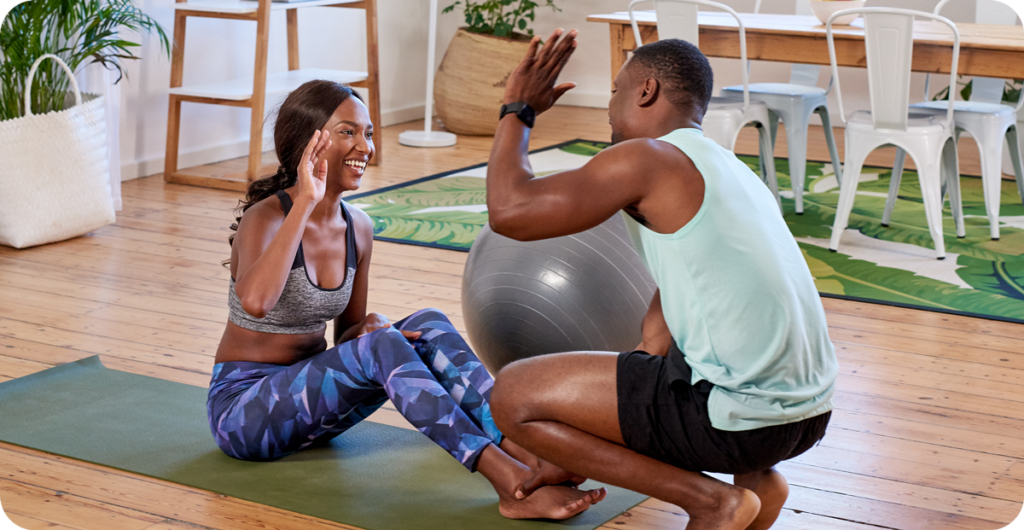

Avery Simmons
We need more Black physical therapists. In 2021, only 5% of Physical Therapists were Black, while 78% were white. In contrast, the population of the United States is 12% Black or African American, and only 58% white (non-Hispanic).
The disparity is obvious. If you’re a PT, you’ve seen it already: in PT school, at conferences, or even in your practice. But why does it matter that there are so few Black PTs? Don’t all PTs do the best they can to treat their patients well, not just the ones that look like them?
In this blog, we’ll review some startling statistics on the number of Black PTs and students. Then we’ll discuss why having more Black Physical Therapists improves patient outcomes, drawing upon scientific medical studies. We’ll discuss why there are so few Black PTs. Finally, we’ll conclude with 5 things PT owners can do to help Black PTs and students.


The Current Situation: Few Black PTs, Even Fewer Black PT Students
In 2021, only 5% of PTs are Black, while 12.1% of the US population is Black; 78% of PTs are white, but only 57.8% of the US population is white (non-Hispanic). Black people have been historically underrepresented in medical professions. But the physical therapy profession is even less representative than physicians at large! In 2021, 8% of physicians overall were Black, compared to 5% of physical therapists. (Come on, guys! We can’t let physicians beat us!)


Source: JobsEQ by Chmura, Q1 2021
But surely there are more Black students in PT school these days? Unfortunately…no. According to a 2016 study by the American Council of Academic Physical Therapy, in 2014-2015 only 4.8% of PTCAS applications were from Black students. That is bad enough. But Black students only made up 2.7% of accepted applicants in the same year. In contrast, white students made up 66.1% of total applicants and 72.1% of admitted applicants.
Black PTs are only making up 2.7% of PT students. That means the pipeline of Black physical therapists graduating is extremely, extremely small. Black students just aren’t applying to PT school, and if they are, many aren’t accepted.
This is happening as the demand for physical therapy is projected to increase as the American population greys…while the population also becomes more racially diverse. By 2060, the US population is projected to be only 44.3% white, while the Black population will make up 15.0% of the population (US Census Bureau).
Source: US Census Bureau
The National Association of Black Physical Therapists puts it this way:
“The population of underrepresented minorities (URM) in the health-related professions does not reflect the increasing population of minorities in the United States. The physical therapy profession is no exception to this – the lack of diversity in the physical therapy field does not mirror the U.S. population nor has it improved with the growth of the profession. There are many initiatives and programs with the centrality on diversity in physical therapy programs, however there still remains a paucity of enrolled URM students in DPT programs AND in URM licensed PTs.”
National Association of Black Physical Therapists
Unless something is done, the field of physical therapy will get more and more out of step with the US population at large.


Black PTs Mean Better Patient Outcomes
The need for more Black physical therapists isn’t just about representation. Research shows that having Black medical professionals leads to better care for Black people. This is crucial, since the health disparities between Blacks and whites run deep.
For example, a 2018 study by the National Bureau of Economic Research set up an experiment that randomly assigned Black men to Black or non-Black doctors. They found that “black men seen by black doctors agreed to more, and more invasive, preventive services than those seen by nonblack doctors. And this effect seemed to be driven by better communication and more trust.” Some key highlights from their study:
- Patients treated by Black doctors agreed to more preventive treatment. “A participant who saw a black doctor was 20 percentage points (47%) more likely to agree to a diabetes screening and 26 percentage points (72%) more likely to accept a cholesterol screening than those who saw a nonblack doctor.”
- Trust was more important than money. “Men were 10 percentage points (56%) more likely to agree to the flu shot if their doctor was black. “Even among men who had been offered the opportunity to get a $5 or $10 incentive to say yes to the flu shot, some of those men had turned that money down, saying, ‘No, I really don’t want a flu shot. I just don’t want a flu shot,’” Dr. Alsan said. “The African-American doctors were able to convince some of those men who had turned down the money to obtain a flu shot.”
- Patients want someone to understand them. “Nearly 65% of black respondents and 70% of white respondents reported that a doctor of the same race would understand their concerns best.” The study clarifies that: “We certainly don’t want people to take away from this that, hey, if you’re not black, you can’t relate to black patients,” Dr. Garrick said. “If anything, you might think, what may I be missing here?”
Trust and communication are even more important in physical therapy, since many patients don’t understand what PT is.
Many patients are afraid that physical therapy will be painful. In order to get patients to say “yes” to different treatment methods (like dry needling) or perform their home exercises, you need patients to trust you. This study shows that when you are dealing with patients of a different racial or ethnic background, you should be doubly conscious that you are communicating well. Having a Black PT on staff could help identify blind spots in your practice.


Plus, Black patients are less likely to seek rehab services than white patients. According to a 2019 study on use of rehab services in Boston, “compared to white patients, African-Americans were 36 percent less likely to use rehabilitation services, and they had 41 percent fewer outpatient visits.” As a PT, you know how crucial it is that people get the care they need. In 2021, Black patients aren’t receiving that care. What would be the impact on your practice if more Black patients came in for therapy?
TaVona Denise Boggs, PT and founder of the Thrive Network, said in WebPT’s 2021 State of Rehab report:
“I have seen firsthand how rehab therapy’s lack of diversity directly impacts therapists’ ability to treat patients within the acute care and outpatient settings. White providers have difficulty relating to, communicating with, and understanding Black patients who frequently use colloquialisms in their speech. This is compounded by the lack of provider understanding around the socioeconomic factors that may be affecting Black, Hispanic, or Asian patients’ ability to “comply” with a treatment plan. This may lead to assuming a patient is lazy or unwilling to participate in their recovery, which in turn breeds distrust of the healthcare provider. Diversifying the rehab therapy industry will make it easier for the underserved and overlooked communities to feel like they are seen, heard, understood, and valued.”
TaVona Denise Boggs
In summary: research suggests that having more Black PTs will improve patient outcomes.
Why Are There So Few Black Physical Therapists?
There is an egregious deficit in Black therapists. But there also are few Black doctors at large.
As a Fortune article put it in 2020, ““Happenstance hasn’t gotten Black doctors very far in medicine, as the numbers show. The reasons for their low percentage in the workforce include many that are shared across the broader conversation about systemic racism: Black Americans have less access to wealth, housing, education, and health care, meaning that Black students interested in becoming physicians generally have more barriers to overcome to enter and stay in the field.”
But why so few Black PTs, specifically? Here’s what a APTA Diversity Report found in 2016:
- Physical therapy is not promoted as a viable career option for underrepresented minority (URM) students in elementary school, secondary school, or higher education.
- Consequently, few URM students apply to DPT programs.
- Even fewer minorities are accepted to those programs.
- URM students complete DPT programs at lower rates than white students.
All these snowball into a catastrophic lack of Black physical therapists. The lack of Black PTs is out of step with the demographics of the United States and, therefore, “cannot reduce health disparities”.


What Can I Do as a Physical Therapy Owner?
So, you’re convinced that the physical therapy field desperately needs more Black physical therapists. Fortunately, as a PT business owner, you have some influence! Here are 5 things you can do to help promote and encourage Black physical therapists:
- Make conscious hiring and staff choices.
How did you first hear about physical therapy? Did you work your way up from the person who did laundry, to a PTA, to getting your degree? As a PT owner, you can make conscious hiring choices, for staff, PTAs, and Physical Therapists. Today’s PTA could be tomorrow’s PT! Increasing the diversity of your hiring could be especially helpful if you’re located in a racially diverse community. Remember, research shows that hiring Black PTs could improve patient outcomes!
- Be a mentor.
Are there Black or underrepresented minority staff / PTs already in your clinic? Choose to be a mentor in their professional development. Check out the National Association of Black Physical Therapists (NABPT) for scholarships, access to a network of Black PTs and students, and other helpful resources. If you yourself identify as Black, you can become a member, participate in the “Each One Teach One” mentorship program, or start a local chapter! The NABPT was founded to “address the emotions and feelings of the lone minorities embarking on a journey to become physical therapists and physical therapist assistants.”
- Engage the community.
The APTA’s Diversity Report showed that students of all ages are not aware that physical therapy is a viable career. As a business owner, you are likely engaged in your local community. At your workshops and other events, make an effort to educate parents and students on the benefits of a career in physical therapy!
- Help with diversity research.
Here’s something you can do TODAY!
Help the NABPT increase diversity in PT education and in the profession at large! Spend 10 minutes and respond to this survey for the NABPT. You do not have to identify as Black to participate.
Are you already working on diversity and inclusion in your clinic? Take 10-15 minutes to share what you’re doing with the APTA!
- Donate.
This year, consider donating to…
- The National Association of Black Physical Therapists. You can choose for your donation to go to the General Fund, Scholarship Fund, Annual Conference Fund, or Black Maternal Health Fund.
- The APTA’s Dimensions of Diversity Fund, which supports the APTA’s efforts to improve diversity, equity, and inclusion with the profession and association.
- The APTA’s Minority Scholarship Fund, which provides scholarships to PT and PTA students and faculty of ethnic and racial minorities.


Physical Therapy is Not “Whole” Until We Diversify
We need more Black physical therapists. As Dr. Lisa VanHoose, PT puts it:
“Our profession as a whole lacks the understanding that we are at a disadvantage without a more diverse workforce. We are not “whole” until we have intentionally diversified the industry. And this lack of diversity directly impacts the ability of therapists and patients to leverage their therapeutic relationship to the fullest. As therapists, it slows down our ability to communicate, understand, and collaborate with patients who differ from us.”
Lisa VanHoose, PT, PhD, MPH Associate Professor and Program Director Physical Therapy Department University of Louisiana at Monroe
What will you do to diversify your practice?











